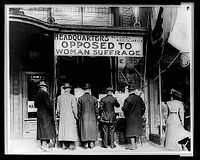- Anti-suffragism
-
Anti-suffragism was a political movement composed mainly of women, begun in the late 19th century in order to campaign against women's suffrage in the United States and United Kingdom. It was closely associated with "domestic feminism", the belief that women had the right to complete freedom within the home. The Women's National Anti-Suffrage League, publisher of the Anti-Suffrage Review, submitted a petition to Parliament in 1907 with 87,500 names, but it was rejected by the Petitions Committee of Parliament as "informal".[1]
In New York, the New York State Association Opposed to Woman Suffrage was founded in 1897, and by 1908 it had over 90 members.[2] It was active in producing pamphlets and publications explaining their views of women's suffrage, until the Nineteenth Amendment to the United States Constitution was passed in 1920. A Geneva branch was founded in 1909.[3] The suffragists in New York often extended invitations to open discussion with the anti-suffragists.[4]
The New York association had its own magazine, first The Anti-Suffragist published by Mrs. William Winslow Crannell from July 1908 to April 1912, later The Woman's Protest produced by the organization at large.
After the passage of the Nineteenth Amendment to the United States Constitution, a coalition of anti-suffragists organized themselves into a political anti-feminist movement in order to "oppose expansion of social welfare programs, women's peace efforts, and to foster a political culture hostile to progressive female activists. They effectively blended anti-feminism and anti-radicalism by embracing and utilizing the hysteria of the post-World War I Red Scare." [5]
Anti-suffragism was not limited to conservative elements. The anarchist Emma Goldman opposed suffragism on the grounds that women were more inclined toward legal enforcement of morality (as in the Women's Temperance Leagues); that women were the equals of men; and that suffrage would not make a difference. She also said that activists ought to advocate revolution rather than seek greater privileges within an inherently unjust system.[6] Progressives criticized suffrage in the Utah Territory as a cynical Mormon ploy, resulting in the passage of the Edmunds-Tucker Act.
See also
References
- ^ Elizabeth Robins, Way Stations (1913), p. 37
- ^ New York State Association Opposed to Woman Suffrage Thirteenth Annual Report, 1908
- ^ Against Suffrage, newspaper clipping, 1909
- ^ Mrs. Mackay's Campaign, newspaper clipping, 25 January 1910
- ^ Nielsen, Kim. "How Did Women Antifeminists Shape and Limit the Social Reform Movements of the 1920s?". State University of New York at Binghamton, 2004. (electronic resource).
- ^ Emma Goldman. "Woman Suffrage". Anarchism and Other Essays, 1911.
Further reading
- Jablonsky, Thomas J, "The Home, Heaven, and Mother Party: Female Anti-Suffragists in the United States, 1868-1920." Brooklyn: Carlson, 1994
- Camhi, Jane Jerome. Women Against Women: American Anti-Suffragism, 1880-1920. Brooklyn, N.Y.: Carlson Pub., 1994. ISBN 0-926019-65-1
- Almroth Wright. The Unexpurgated Case Against Woman Suffrage. London: Constable & Co. Ltd, 1913. Available online: Works by Almroth Wright at Project Gutenberg
- Harrison, Brian Howard. Separate Spheres : The Opposition to Women’s Suffrage in Britain. London : Croom Helm, 1978.
- Nielsen, Kim. How Did Women Antifeminists Shape and Limit the Social Reform Movements of the 1920s?. Binghamton, NY: State University of New York, 2004 (electronic resource).
Categories:- Anti-suffragism
- Criticism of feminism
- Social theories
Wikimedia Foundation. 2010.


